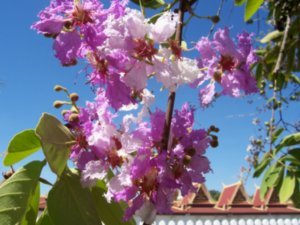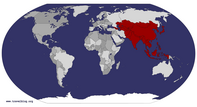Advertisement
Published: April 9th 2008

 Arrival in Phenom Penh
Arrival in Phenom Penh
Another Asian Capital City, but not too bad. It was evacuated by Pol Pot between 1975 and 1979, so, part modern and part rundown#10 CAMBODIA-Part 2
PHNOM PEHN
I did not stay too long in this city. I arrived late in the only bit of rain I experienced in Cambodia, so took the first hotel offered to me by a tuk-tuk driver. It was OK but a bit flash and very expensive at $16 a night. It was convenient to the river and Museum, just around the corner.
So I spent about a day and half here visiting museum, river, Royal Palace, temples, back streets, main market, lake etc. I spent quite a bit of time wandering around the huge yellow Art Deco markets built by the French. It is a massive labyrinth of alleyways selling everything with what seems to be no or little planning at all in the layout of stalls; more interesting chaos.
FUN WITH MONEY AND GETTING AROUND IN TOWNS
It was still hot, so I got around in many short trips on the back of motor cycles. They are everywhere; just turn you head to face the road; a bike will stop; point to your map; negotiating price (“Two dollar”. “No, No. One dollar”.” OK, OK”) does not take long, flip your leg over

 Arrival in Phenom Penh
Arrival in Phenom Penh
Royal Highness hotel was as good as any to make a startthe back seat and your on your way.
The local currency here is the ‘Reil” but most people use American Dollars. There are no coins for either currency. There are 4000 Reils to the dollar, so your wallet can get a bit think with both currencies, especially if you end up with a handful of 100 (or even 50) Reil notes in your change ( I call it ‘Wallpaper Money’)
Every thing is so cheap here: good hotels $6-$16; delicious big meals $2; Tuk-tuks one or two dollars for a couple of Kilometers; luxury buses for $4 for a trip over a hundred kilometers. I don’t know how they do it, since petrol is about the same price as in Australia (!!?!)
You soon learn to take about $20 or $30 with you every day in single $1 notes. Local rides on tuk-tuks, back of motorbikes, bottled water, canned drinks, freshly juiced thick tropical fruit drinks, entrances to tourist spots and other odds’n’ends are all around about $1 each; very convenient. The worst is when you get something for UNDER a dollar; then you have to hassle around with the 'wallpaper money' again. (”Oh, No! That’s OK.

 Arrival in Phenom Penh
Arrival in Phenom Penh
Internet cafe across the street from hotel….Keep the change.”)
Phnom Pehn was very nice, but there are too many things to see in the rest of the country and by now I really needed a rest, so I headed for the South coast.
KAMPOT
Kampot is a provincial capital city on a river and people come here because it’s quiet with nice restaurants on the river with pleasant sunset views. Once again the French buildings here are very run down, (see video)but a pleasant town to walk around.
There are also limestone caves worth exploring in the area. I am now getting a bit soft towards the end of the trip and decide to take an air-conditioned taxi to these to avoid the heat, dust and rough ride. Here young school kids will guide you thru the caves for $1 going towards school books and a chance for free English lesson at same time. They know their way around the pitch blackness in the caves. Luckily, I bought my own torch.
They are huge in parts but then you have to crawl thru in other parts. There are bats and the remains of temples destroyed by Pol Pot’s soldiers once again. Giant

 National Museum
National Museum
Beautiful building built by Frenchtree roots come into the caves from above. Altogether, well worth the effort.
KEP
I continue on in my taxi to a beach town of Kep, another French beach resort town here, back from the beach there are (or I should say ‘were’) many old beautiful French Mansions. These were also destroyed by Pol Pot’s men and many now are just burnt out shells, but you can still wander around and explore them. The forests are also starting to take over here. Maybe it could become a new Angkor Wat (??)
The beach here is OK but time to move on to the next and final destination.
SIHANOUKVILLE
I shared a taxi with German guy, which was about same price as the bus to this new and upcoming beach resort area. It will probably become like Surfers Paradise soon. I took his advice and went to an expensive hotel at $12 a night, overlooking the ocean. The idea was to relax a bit now and have ‘a bit of a holiday’ and do nothing, but lie on the beach.
The thing is; which beach do you lie on? There are many beaches in this area,

 National Museum
National Museum
the roof was multicolored, but discolored by bat droppings from bats living in Museum verandahs. all gone now, unfortunately.so I spent most of the next day exploring them all on the back of a motor bike. The beaches here are now beginning to take off with the expect tourist boom of a new rich Asia from China, India, Vietnam and others. Hotels are going up everywhere near the beaches and in a few years it will all look very different.
I eventually found a beach to lie on (the one closest to my hotel) and did manage to spend a couple of hours around sunset, laying a deck chair on the beach.
By now the last two weeks had caught up with me and I crashed out badly with a case of ‘the runs’
Luckily my ‘getting a little soft’ at the end of the trip is good timing, since I booked a plane ride from Phnom Penh to Seim Reap the day before flying home to Korea and a luxury bus to Phnom Penh (with a toilet on board - a very important ‘comfort item’ now)
I spent the last day, not doing much at all-just ‘vegging’ out in front of TV and cruising around Seim Reap where I started out two weeks earlier, but

 National Museum
National Museum
. Internal courtyard and gardensnow exhausted.
CAMBODIAN TV
All the hotel rooms have satellite TV (even the $6 ones!) so I caught up on some while ‘crashed out’. Cambodia has become a really ‘International‘ with all the money and help from the UN and richer countries after the devastation cause by Pol Pot and civil wars etc. this is reflected in the TV stations. There are Cambodian TV stations of course, which are a little old fashion but OK. American News , movies and other stations are here as expected. There are many European stations as well from countries such as England, Italy, Germany, France and others. Asia is also well represented with countries such as India, Thailand, Vietnam, China, Korea, Japan and others which I am not quite sure about.
It is interesting flicking thru channels with German shows dubbed into English with Cambodian subtitles; or Japanese show dubbed into Cambodian with Italian subtitles; there so many combinations; the mind boggles.
There is even one Australian channel here called “Australian Network”. It seems to be a Channel with old and new shows from all the Australian channels back home, commercial, SBS and ABC. The news from Australia is thankfully ABC. ‘Interesting to
hear the Aussie accent again; really weird among all the other international languages.
TIME TO LEAVE
In my two weeks here I don’t think I have had one hassle, or seen anybody else have any hassles. Of course there are a lot of problems here and bad things do happen all the time I am sure, but other travelers have said the same thing. You also don’t see many old or middle aged people around; maybe also due to the many recent civil wars.
After coming from one of the most advanced civilizations in the world at one time, to one of the most oppressed in the last century it is good to see their positive spirit still getting stronger. They are still suffering from the past colonization from Thailand, Vietnam, the French, the American bombings, Pol Pot and many civil wars, hidden mines, limbless children, poverty, exploitation, and so on. They really know how to make the most of a bad situation and are very resourceful.
Even the streets-kids can go from playing; to haggling and chatting with tourists and becoming multicultural at the same time; to collecting cans and bottles for recycling; and back to
playing with friends again; all in less than a minute; all without offending anybody. Kids driving motorbikes, motorized canoes to school, bamboo trains, finding their way around caves in the dark, selling souvenirs and becoming multilingual entrepreneurs is inspiring when you think about some of the kids in richer countries complaining about ‘how tough life is now because their mobile phone battery is flat’.
Many business people in third world countries can be very pushy and competitive, but it seems that they will leave you alone after you say “No, thank you” -once or twice. Of course, it depends where you are and it could get worse in the future, but basically they were very polite. If there are many wanting your business, they may jostle and push each other, but they only do it in fun.
The sellers want your tourist dollar and sometimes try to ‘talk’ you out of it, but not aggressively. They use many common English phrases which actually have different meaning to them then they do for us. Here are some of the phrases they use and with my translations in brackets. (all in fun of course)
Tourist (too rich);
Hello, hello, where you

 National Museum
National Museum
Part of rare bronze statue from Angkorfrom? (I want to sell you something)
Hello, hello. (I want to sell you something)
No buy, just look (No look, just buy)
Same, same, but different. (I don’t have what you want, but I am going to sell you what I have.)
By now, I am really exhausted after two weeks of temple-jungle treks; shaken around by boats and bumpy trucks / tuk-tuk / bamboo train and motorcycle rides over dusty potholes, not to mention crawling thru caves, but it was all worth it.
I’ll never forget this place. The dust, heat, trees eating temples, the new French ruins, French baguettes and cheese, spicy coconut milk meals, fresh tropical fruit shakes, bone shattering rides and many unexpected sites. But most of all I will never forget the people with their attitude to life and friendly smiling faces.
I was very envious of the other younger travelers I met who were in the middle of a 3 or 4 month journey thru South East Asia using local transport. It is good to see that people still do that. I would like to come back again one day soon, maybe in the wet season, but now it was
back to Korea and work, feeling much more relaxed and refreshed (in spite of the tummy bug).
Next blog-back in Korea and Spring travels
Advertisement
Tot: 0.139s; Tpl: 0.013s; cc: 7; qc: 24; dbt: 0.0481s; 1; m:domysql w:travelblog (10.17.0.13); sld: 1;
; mem: 1.1mb





















Sue Storr
non-member comment
Want to go too!
Hi John, great blog! My goodness you went crazy with the photos, eh? Confirms that I must travel to Cambodia sooner rather than later! Sue